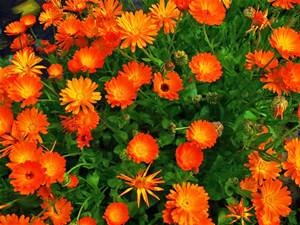
As you clean up your garden and remove summer annuals, take care to banish weeds and their seedpods, too. Pick up a truckload of well-aged compost, or schedule a delivery, from one of Napa County's two excellent compost companies. Nourish tired garden soil with fertilizers that replace potassium and phosphorous. After you fertilize and amend soil, water well to disperse the nutrients. If your fertilizer comes in a bag, box or bottle, carefully follow abel directions.
Be merciless in removing weed seedpods. However, if you grew calendulas, violas, forget-me-nots or zinnias, shaking their seed heads as you weed will reward you with color spots the following spring. Even some edible crops like lettuce, onions and parsley will often reseed if you encourage them.
In fact, some annuals are such vigorous self-sowers thatWeeds of California and Other Western States,a University of California publication, considers them weeds. Violets, forget-me-nots and many others are in this group. Luckily for me, they are some of my favorite flowers. Denim-blue or yellow violas, sweet-scented purple violets (Viola odorata) and bold-faced pansies ranging from deep blue to pink can all be planted now. Plant violas in garden beds and put more in pots to bring some cheer to the coming winter days.
Tuck calendulas, also called pot marigolds, in any bare spot in the garden, and they will reward you with bright gold flowers throughout the winter. They will fade in summer's heat, but then a shake of their tough little seed heads will sow the next season's color. In the kitchen, calendula petals can brighten salads and are sometimes used as a “poor man's saffron.”The golden petals can tint rice dishes and other recipes needing a dash of color.
Plant perennials and California natives now so they can benefit from still-warm soil and grow strong before winter comes. If you plant foxglove seedlings from six-packs now, they will be six feet tall and have towering blossoms by next year. Small snapdragon plants, which children will enjoy, will be covered with little snappers by summer and provide bright flowers through the winter months, too.
Even decorative vegetables can perk up a walkway or bed. Pink and lime-green cabbages and vivid purple and red kales can provide color all winter long.
Sow seed now for the golden California poppies and red poppies that grace many an Impressionist canvas. It's a good time to sow other wildflowers, too, before the rains come. Look for seed packets of your favorites, or pick up one of the many wildflower blends formulated for shady or sunny spots.
Bulbs, corms and tubers are on nursery shelves now. Plant daffodils, sparaxis and freesia in garden beds or pots to brighten decks and indoor rooms. Some bulbs do benefit from pre-chilling, so read directions that come with the bulbs. Make sure beds and pots have good drainage.
Although many people are removing lawns, October is a good month to plant new lawn or renovate an older one. Over-seed now to correct bare or stressed spots.
Napa County Cooperative Extension recommends a premium blend of grass formulated for California's cooler growing areas. If you are curious about which turf grass is best, you can get reports from Cooperative Extension on how the different grasses and blends perform. Lawns and turf are often criticized as being wasteful of water, but they do provide some fire protection around a home.
Sweet peas can be planted now. Dig beds deeply and amend with aged compost.Tall varieties can be grown along fences or trellises and short varieties in beds or containers. Heirlooms with rich fragrances are my favorites, but last year I planted a dwarf sky-blue variety that bloomed tirelessly in a half barrel on the deck until the first summer heat finished them.
October weather can be varied, so be vigilant a little longer. Pay attention to weather forecasts and protect your new seed sprouts and tender seedlings from any final scorching days. Windy days zap moisture from air and soil, so make sure young plants are weathering those conditions, too.
Workshop: U. C. Master Gardeners of Napa County will host a workshop on “Citrus” on Saturday, October 24, from 9:30 a.m. to 11:30 a.m., at the University of California Cooperative Extension Office, 1710 Soscol Avenue, Napa. This workshop will focus exclusively on caring for citrus, large and small. Potting and repotting container citrus, pruning, watering and fertilizing, frost protection and recovery from frost damage are part of the program. The workshop will also cover using the University of California IPM website to identify and understand citrus disease and pests.Online registration (credit card only); Mail-in registration (cash or check only).
Master Gardeners are volunteers who help the University of California reach the gardening public with home gardening information. U. C. Master Gardeners of Napa County ( http://ucanr.org/ucmgnapa/) are available to answer gardening questions in person or by phone, Monday, Wednesday and Friday, 9 a.m. to Noon, at the U. C. Cooperative Extension office, 1710 Soscol Avenue, Suite 4, Napa, 707-253-4143, or from outside City of Napa toll-free at 877-279-3065. Or e-mail your garden questions by following the guidelines on our web site. Click on Napa, then on Have Garden Questions? Find us on Facebook under UC Master Gardeners of Napa County.